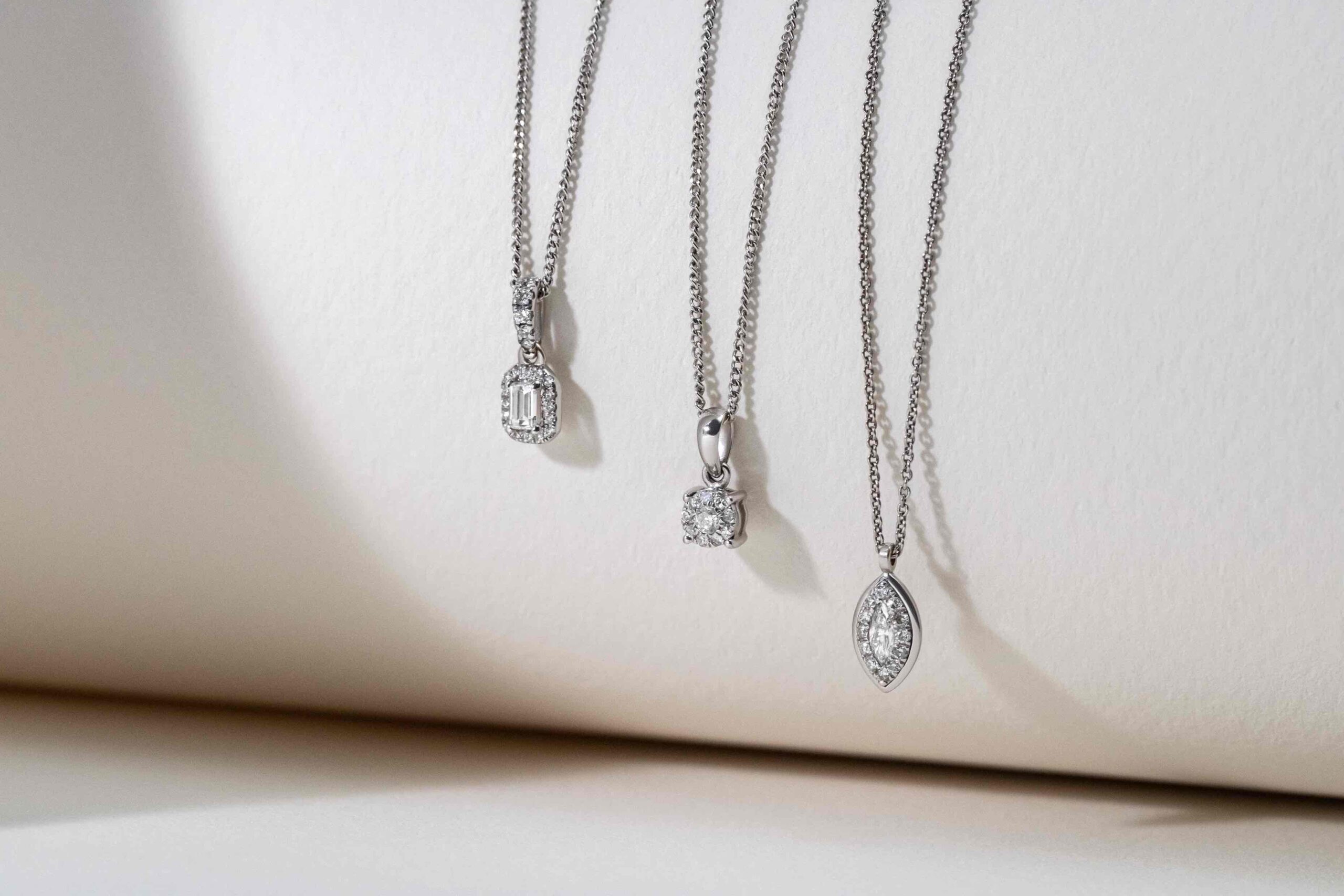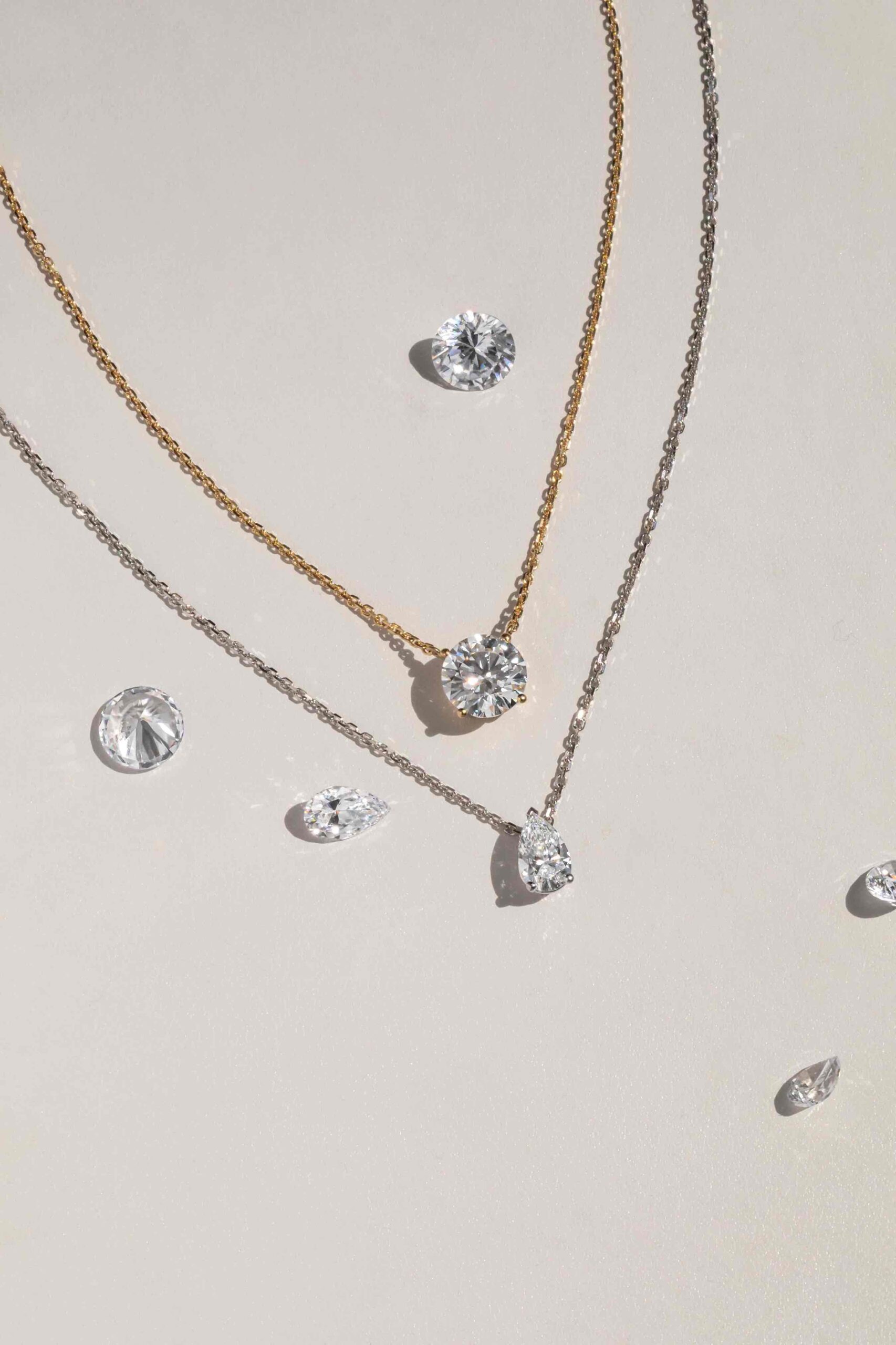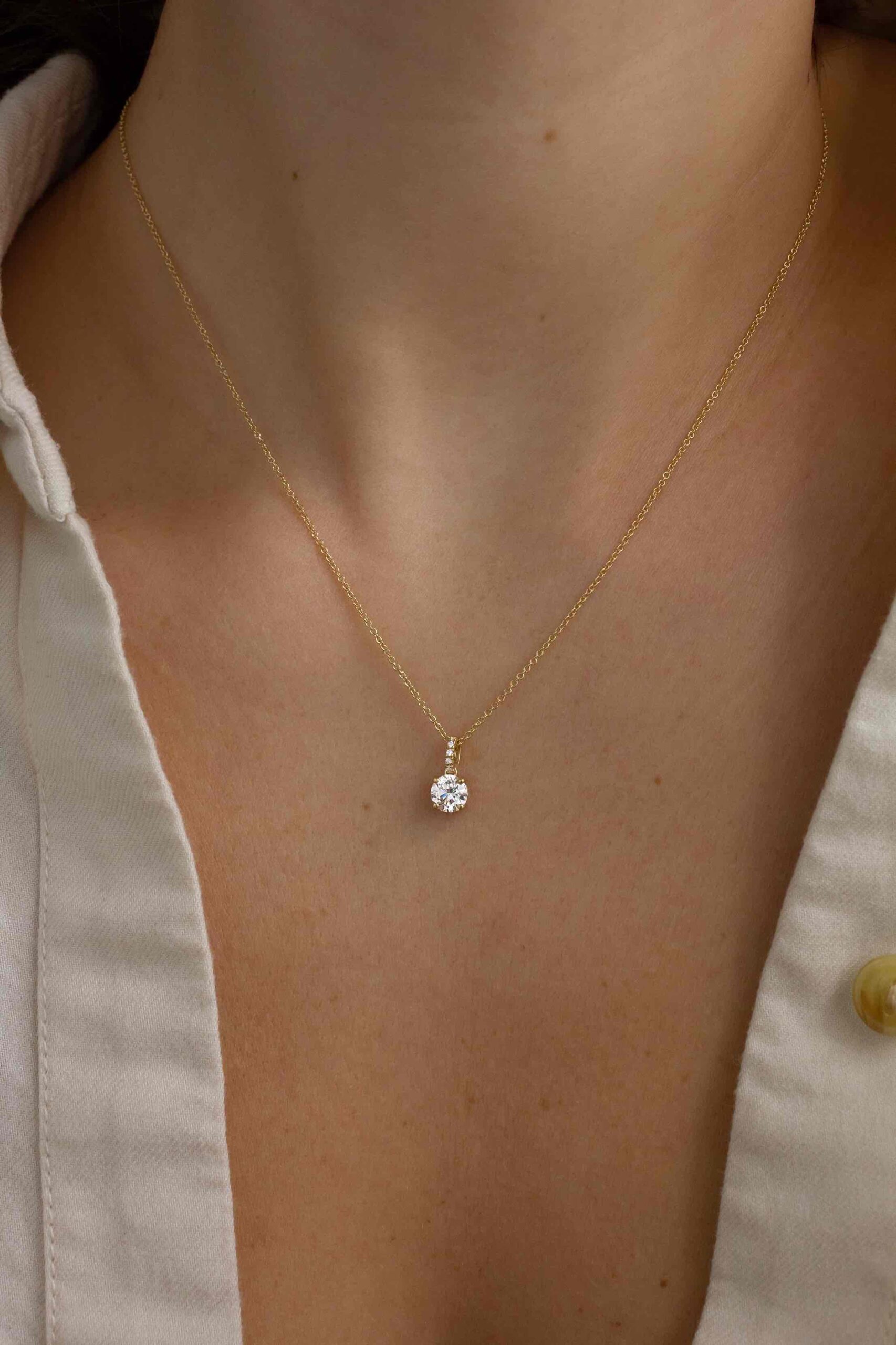
26 Mar 2025 — by Flawless Fine Jewellery — Reading time 12 minutes
How to Choose the Perfect Diamond Necklace
The Knowledge You Need To Find Your Perfect Gemstone
Introduction to Diamond Necklaces
A diamond necklace is a symbol of elegance, sophistication, and lasting beauty. Its brilliance never fades, making it a classic piece that transcends trends. Whether worn for special occasions or everyday glamour, its versatility ensures it complements any outfit effortlessly. Diamonds represent love and strength, adding sentimental value to every piece. With proper care, a diamond necklace becomes a cherished heirloom, passed down through generations. Its association with royalty and fashion icons further cements its status as a timeless accessory, making it a must-have in any jewelry collection.
Why choosing the right diamond necklace matters?
Selecting the right diamond necklace is essential for both style and value. The perfect piece enhances your look, whether for everyday wear or a special occasion. Factors like diamond quality, setting, and metal choice affect its brilliance, durability, and comfort. Well-chosen diamond necklaces also hold sentimental and financial value, making it a timeless investment. By considering craftsmanship and authenticity, you ensure a piece that remains elegant and cherished for years to come.

Topics covered:
Understanding Diamond Necklaces: Types & Styles
The 4Cs of Diamonds: Choosing the Right Diamond for Your Necklace
Best Metal Choices for a Diamond Necklace
Diamond Necklace Lengths & How to Choose the Right One
Lab-Grown vs. Natural Diamond Necklaces: What to Consider
How to Choose the Perfect Diamond Necklace for Different Occasions
Where to Buy a High-Quality Diamond Necklace
How to Care for Your Diamond Necklace
FAQs About Diamond Necklaces
Understanding Diamond Necklaces: Types & Styles
Popular diamond necklace styles:
A solitaire diamond necklace is a timeless and elegant piece featuring a single diamond as its focal point. Its simplicity highlights the diamond’s brilliance, making it a versatile choice for both everyday wear and special occasions. Available in various cuts, such as round, princess, or pear, it can be set in different metals like white gold, yellow gold, or platinum. The minimal yet sophisticated design ensures it never goes out of style, making a solitaire diamond necklace a classic addition to any jewellery collection.
Halo diamond necklace
A halo diamond necklace features a central diamond surrounded by a circle of smaller diamonds, enhancing its brilliance and creating a dazzling effect. This design adds extra sparkle and makes the centre stone appear larger, offering a luxurious look. Available in various shapes and metal settings, it suits both classic and contemporary styles. The halo diamond necklace is a perfect choice for those who love a statement piece with added brilliance and elegance.
Tennis diamond necklace
A tennis diamond necklace is a stunning piece featuring a continuous row of diamonds, creating a sleek and elegant look. Known for its timeless appeal, this necklace offers brilliance from every angle, making it a perfect choice for formal events or everyday luxury. Typically set in white gold, yellow gold, or platinum, it provides a seamless and sophisticated finish. The tennis diamond necklace is a must-have for those who appreciate classic, radiant jewellery with lasting style.
Pendant diamond necklace
A pendant diamond necklace features a single diamond or a cluster of diamonds suspended from a chain, creating an elegant and timeless look. These necklaces are versatile, making them perfect for both everyday wear and special occasions. Popular styles include solitaire pendants, halo designs, and intricate motifs. When choosing a pendant diamond necklace, consider the diamond’s cut, clarity, and setting, as well as the chain length and metal type to complement your style.
Gemstone necklace
A gemstone necklace combines the brilliance of diamonds with the vibrant allure of precious stones such as sapphires, emeralds, or rubies. These necklaces add a touch of colour and individuality to any jewellery collection. When choosing a gemstone necklace, consider the quality and origin of the stones, their cut and setting, and how they complement the diamonds. Whether opting for a classic diamond and sapphire combination or a bold, statement piece, gemstone necklaces offer elegance with a unique personal touch.
Choker diamond necklace
A choker diamond necklace sits closely around the neck, offering a bold yet sophisticated look. Available in styles ranging from delicate single-row diamonds to intricate, statement designs, chokers add glamour to both casual and formal attire. When choosing a choker, consider the necklace length, diamond setting, and metal type to ensure comfort and a flattering fit. Perfect for layering or wearing alone, a diamond choker is a timeless piece that exudes elegance.

The 4Cs of Diamonds: Choosing the Right Diamond for Your Necklace
Diamond necklace cut – How it affects sparkle and brilliance
The cut of a diamond is the most crucial factor in determining its brilliance. A well-cut diamond reflects light beautifully, creating maximum sparkle. Popular cuts for necklaces include round brilliant, princess, and oval cuts, each offering a unique look. A poorly cut diamond, regardless of its clarity or carat weight, may appear dull. Opt for an excellent or very good cut grade to ensure your necklace radiates elegance.
Diamond necklace clarity – Understanding inclusions and blemishes
Clarity refers to the presence of inclusions (internal flaws) and blemishes (surface imperfections) in a diamond. The fewer the flaws, the clearer and more valuable the diamond. For necklaces, a diamond with SI1 or SI2 clarity offers a balance of quality and affordability, as minor inclusions are less visible when worn. However, if choosing a larger centre stone, consider a VS clarity grade or higher for a more flawless appearance.
Diamond necklace color – How color grading impacts appearance
Diamond colour is graded from D (colourless) to Z (light yellow or brown). Colourless diamonds (D-F) are the most valuable and provide a pristine look. However, near-colourless diamonds (G-H) offer great value, as the slight warmth is barely noticeable once set in a necklace. The choice of metal also plays a role—white gold and platinum enhance the cool tones of colourless diamonds, while yellow or rose gold complements warmer diamonds.
Diamond necklace carat weight – Finding the right size for your budget
Carat weight affects both the size and price of a diamond. While larger diamonds are more eye-catching, they also come at a premium. When choosing a diamond necklace, consider the setting style and overall design—a well-cut smaller diamond can appear larger due to its brilliance. For solitaire pendants, a 0.50 to 1.00 carat diamond is a popular choice, while multi-stone necklaces can achieve a dazzling effect with smaller diamonds arranged beautifully.
Best Metal Choices for a Diamond Necklace
The choice of metal significantly impacts the appearance, durability, and overall value of a diamond necklace. Popular options include white gold, yellow gold, rose gold, platinum, and silver, each offering a unique aesthetic and level of maintenance. When selecting the metal, consider factors such as skin tone, personal style, and daily wearability to ensure the perfect match for your diamond necklace.
White gold diamond necklace vs. yellow gold diamond necklace
A white gold diamond necklace has a sleek, modern appeal and enhances the brilliance of diamonds by reflecting light. It is durable and plated with rhodium for added shine and protection. However, it may require occasional re-plating to maintain its bright white colour.
A yellow gold diamond necklace offers a classic and warm look, complementing vintage and traditional jewellery styles. It pairs well with diamonds that have a slightly warmer hue (G-J colour) and requires less maintenance than white gold. While softer than platinum, higher-karat yellow gold (18K) is more resistant to tarnish and wear.
Platinum diamond necklace vs. silver options
A platinum diamond necklace is the ultimate choice for luxury and durability. Platinum is a naturally white metal that does not fade over time, making it ideal for preserving a diamond’s brilliance. It is also hypoallergenic and highly resistant to scratches, though it develops a patina over time, which some wearers appreciate for its antique look.
A silver diamond necklace is a more affordable alternative but requires regular maintenance. Sterling silver (92.5% pure silver) is prone to tarnishing, needing frequent polishing to retain its shine. While beautiful, silver is also softer than platinum and gold, making it more susceptible to scratches and bending.
How metal choices affect the overall look and durability
The metal you choose influences how your diamond necklace appears and how well it withstands daily wear. White metals (platinum and white gold) enhance the diamond’s sparkle, while yellow and rose gold add warmth and vintage charm. Platinum is the most durable but comes at a higher price, whereas gold offers a balance of elegance and practicality. Silver is budget-friendly but requires more upkeep. Choosing the right metal ensures your diamond necklace remains a cherished and long-lasting piece.
Diamond Necklace Lengths & How to Choose the Right One
The length of a diamond necklace affects both its style and how it complements different outfits. Choosing the right length depends on personal preference, neckline, and occasion. From short chokers to long opera necklaces, each length creates a unique look and level of elegance.
Common Diamond Necklace Lengths:
14-inch Choker Diamond Necklace – Sits snugly around the neck, offering a bold and sophisticated look. Ideal for off-shoulder or V-neck outfits.
16-inch Princess-Length Diamond Necklace – A versatile choice that rests just below the collarbone, perfect for everyday elegance or layering.
18-inch Matinee Diamond Necklace – Slightly longer, this length works well with higher necklines and adds a refined touch to formal attire.
Longer Opera and Rope Diamond Necklaces – Opera (28-36 inches) and rope (over 36 inches) necklaces create a dramatic and luxurious look, ideal for layering or styling with evening wear.
Matching Diamond Necklace Lengths to Different Necklines and Occasions
– Chokers complement strapless or low-cut dresses for a striking effect.
– Princess-length necklaces suit almost any outfit, making them a popular everyday choice.
– Matinee necklaces work well with business or semi-formal wear.
– Opera and rope necklaces add glamour to evening gowns and layered looks.

Lab-Grown vs. Natural Diamond Necklaces: What to Consider
When choosing between a lab-grown and natural diamond necklace, it’s important to understand their differences in origin, price, and ethical impact. While both offer stunning brilliance, they cater to different preferences and budgets.
Differences Between a Natural Diamond Necklace and a Lab-Grown Diamond Necklace
– Natural diamonds are formed over millions of years beneath the Earth’s surface, making them rare and highly valued.
– Lab grown diamonds are created using advanced technology to replicate the natural process, offering the same physical and chemical properties at a lower cost.
Price Comparison and Ethical Considerations
– Lab diamonds are typically 40-60% more affordable than natural diamonds of the same quality.
– Natural diamonds hold higher resale value due to their rarity.
– Lab-grown diamonds are a sustainable and ethical choice, avoiding the environmental impact and ethical concerns associated with diamond mining.
Pros and Cons of Each Option
Feature Natural Diamond Lab-Grown Diamond
Rarity High Less rare
Price More expensive More affordable
Ethics Mining concerns Eco-friendly and conflict-free
Brilliance & Durability Identical to lab-grown Identical to natural
How to Choose the Perfect Diamond Necklace for Different Occasions
A diamond necklace is a timeless accessory, but the ideal style depends on the occasion. From subtle everyday pieces to statement designs for special moments, choosing the right necklace enhances both elegance and significance.
– Everyday Wear vs. Special Occasions – For daily wear, opt for a simple solitaire pendant or delicate diamond station necklace. Special occasions call for bold statement pieces like diamond chokers or layered designs.
– Best Diamond Necklaces for Weddings and Engagements – Bridal jewellery often includes classic tennis necklaces or elegant drop pendants, adding sophistication to wedding attire.
– Ideal Diamond Necklace Gifts for Birthdays, Anniversaries, and Milestones – A diamond pendant or personalised necklace makes a meaningful birthday or anniversary gift, while a halo or heart-shaped diamond necklace is perfect for milestone celebrations.
Where to Buy a High-Quality Diamond Necklace
Purchasing a diamond necklace is a significant investment, so selecting the right jeweller like Flawless Fine Jewelry is essential. For premium quality, certified diamonds, and expert craftsmanship, shopping at a reputable location ensures both beauty and value.
Why Hatton Garden Is the Best Place for Diamond Necklace Shopping
Hatton Garden, London’s historic jewellery district, is renowned for its exceptional diamond selection, expert jewellers, and competitive pricing. With numerous specialists offering both natural and lab-grown diamond necklaces, buyers have access to a diverse range of designs, from classic solitaires to bespoke creations. Jewellers like Flawless Fine Jewellery provide personalised service, certified diamonds, and customisation options, making Hatton Garden the ideal destination for fine jewellery shopping.
How to Find a Reputable Diamond Necklace Jeweller
A trusted jeweller should offer:
– Diamond certification from GIA, IGI, or HRD for authenticity and quality assurance.
– Transparency in pricing, including details on the 4Cs (Cut, Colour, Clarity, and Carat weight).
– Customisation services for unique, tailor-made designs.
– Positive customer reviews and a strong reputation for excellence.
What to Check Before Purchasing a Diamond Necklace
Before finalising your purchase, ensure the jeweller provides:
– Diamond certification verifying authenticity and quality.
– A solid warranty covering craftsmanship and possible defects.
– A clear return or exchange policy for peace of mind.
– Aftercare services, such as cleaning, resizing, or maintenance.
For a high-quality, expertly crafted diamond necklace, Flawless Fine Jewellery in Hatton Garden is a top choice, offering superior craftsmanship, certified diamonds, and exceptional customer service.
How to Care for Your Diamond Necklace
Proper care keeps your diamond necklace sparkling and ensures its longevity. Regular cleaning, safe storage, and periodic professional servicing help maintain its brilliance and structural integrity.
How to Clean a Diamond Necklace at Home
To keep your necklace looking radiant, clean it gently:
– Mix warm water with mild dish soap and soak the necklace for 10–15 minutes.
– Use a soft-bristled brush to remove dirt from the setting and chain.
– Rinse thoroughly and pat dry with a lint-free cloth.
– Avoid harsh chemicals or ultrasonic cleaners unless recommended by your jeweller.
Proper Storage Tips for Keeping Your Diamond Necklace Safe
– Store in a padded jewellery box or a soft pouch to prevent scratches.
– Keep it separate from other jewellery to avoid tangling and friction.
– Consider a jewellery organiser with individual compartments for added protection.
When to Get Professional Servicing for Your Diamond Necklace
– Have your necklace checked annually by a jeweller, like Flawless Fine Jewellery, to inspect for loose stones or worn prongs.
– Get professional cleaning and polishing to restore its shine.
– Seek immediate servicing if you notice loose settings, bent clasps, or dullness that doesn’t improve with home cleaning.
FAQs About Diamond Necklaces
1. How do I know if my diamond necklace is real?
Look for GIA, IGI, or HRD certification, check its brilliance under light, and do a fog test—real diamonds disperse heat quickly. Buying from a trusted jeweller like Flawless Fine Jewellery ensures authenticity.
2. What is the best length for a diamond necklace?
The ideal length depends on personal style and occasion. 16-18 inches (princess length) is the most versatile, while 14-inch chokers are bold and longer opera styles suit formal wear.
3. Can I wear my diamond necklace every day?
Yes, but choose a durable setting and metal like platinum or 18K gold. Avoid exposing it to harsh chemicals, and store it properly when not in use.
4. How much should I spend on a diamond necklace?
Prices vary based on diamond size, quality, and metal. A high-quality diamond pendant starts from £500, while statement pieces can cost thousands. Set a budget that balances quality and affordability.
5. Is a diamond necklace a good investment?
High-quality natural diamonds retain value over time, especially certified pieces with excellent cut and clarity. While not a quick-profit investment, a diamond necklace is a timeless, valuable asset.
6. What is the most popular style of diamond necklace?
The solitaire diamond pendant is the most popular due to its classic elegance and versatility. Tennis necklaces and halo pendants are also trendy for a more luxurious look.
7. Do diamond necklaces lose their value over time?
High-quality natural diamonds with GIA certification tend to retain value, especially rare or high-carat diamonds. Lab-grown diamonds, however, have lower resale value.
8. How do I clean my diamond necklace at home?
Soak it in warm water with mild soap, gently scrub with a soft-bristled brush, rinse, and pat dry with a lint-free cloth. Avoid harsh chemicals.
9. Can I shower or swim with my diamond necklace on?
It’s best to remove your necklace before showering or swimming to prevent exposure to chemicals, soaps, and chlorine, which can dull the diamond and damage the metal.
10. How often should I get my diamond necklace professionally checked?
Have your necklace inspected once a year by a jeweller like Flawless Fine Jewellery to check for loose stones, worn prongs, or signs of damage.
11. What is the difference between a diamond tennis necklace and a diamond pendant?
A tennis necklace features diamonds set all around the chain, offering a luxurious, continuous sparkle. A pendant necklace has a single diamond or a small cluster hanging from a chain, offering a more delicate look.
12. Can I customise a diamond necklace?
Yes! Many jewellers, including Flawless Fine Jewellery, offer customisation services, allowing you to choose the diamond shape, metal type, and necklace design.
13. What is the best setting for a diamond necklace?
A prong setting maximises sparkle, while a bezel setting offers better protection. Halo settings enhance the diamond’s size and brilliance.
14. How do I choose a diamond necklace as a gift?
Consider the recipient’s style—a solitaire pendant suits classic tastes, while a diamond choker or tennis necklace is perfect for statement jewellery lovers.

